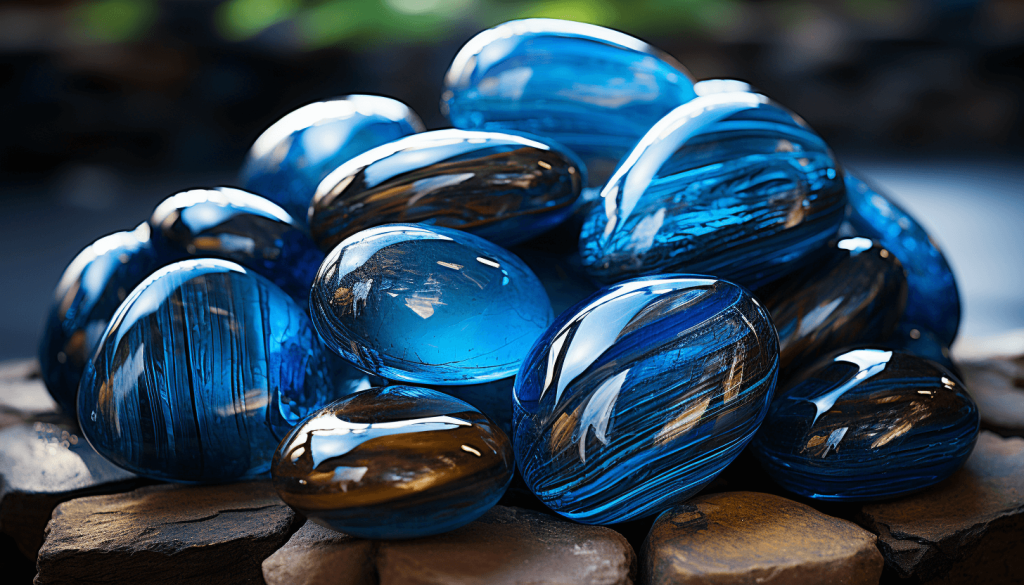Blue Tiger’s Eye, often called Hawk’s Eye, is a mesmerizing stone that captivates with its silky, luminous streaks of blue and grey. Derived from the Quartz family, it inherits its distinctive appearance due to the crocidolite fibers within it. As the stone undergoes natural transformation over time, Quartz replaces these blue crocidolite fibers, resulting in the chatoyant bands known for by the Tiger’s Eye family. Although it shares similarities with Agate in terms of its banding, Blue Tiger’s Eye stands out due to its unique blue sheen and reflective qualities.
Just as the all-seeing Eye of a hawk is sharp and precise, the Blue Tiger’s Eye has been revered for centuries for its potential to provide clarity and insight. Whether captivated by its shimmering appearance or the rich lore surrounding it, delving deeper into the world of the Blue Tiger’s Eye can be enlightening.
The stone’s lineage begins with its kinship to the larger Tiger’s Eye family. While the golden-brown variant is more commonly recognized, the blue shade is especially sought after by gem enthusiasts and spiritual seekers alike. Its tranquil hues hint at its calming energies, and many believe it can be a beacon of relaxation and insight in tumultuous times.
When looking at the broader realm of gemstones, it’s worth noting the similarities and differences between Blue Tiger’s Eye and Agate. Both are silicate minerals, and both exhibit banding patterns. However, the reflective and silky luster of Blue Tiger’s Eye, caused by its fibrous structure and chatoyancy, sets it apart. This optical effect, where bands of light seem to glide on the stone’s surface as it moves, is particularly pronounced in Blue Tiger’s Eye, making it a gem of visual intrigue.
Mining Regions of Blue Tiger’s Eye
Blue Tiger’s Eye is a unique variant of the Tiger’s Eye family, and its deposits are more limited than its golden-brown counterpart. As with many gemstones, the location of its mining can play a role in its quality and unique visual characteristics.
| Region | Characteristics | Notes |
|---|---|---|
| South Africa | Rich blue sheen with consistent banding. | South Africa is the primary source and is renowned for high-quality specimens. |
| Australia | Deep blue to greyish bands, sometimes mixed with golden hues. | Though less abundant than South African deposits, the Australian Blue Tiger’s Eye is equally prized. |
| India | Darker shades of blue with interspersed golden sections. | Indian variants tend to be rarer and have a more eclectic mix of colors. |
| USA (California and Arizona) | Subdued blue tones with occasional green hints. | the US provides unique color combinations while not the primary source. |
| Canada | Lighter blue shades with even banding. | Canadian mines are fewer, but they produce good quality Blue Tiger’s Eye. |
Frequently Asked Questions
How rare is blue tiger eye?
Blue Tiger’s Eye, also known as Hawk’s Eye, is rarer than the typical golden-brown Tiger’s Eye. Its unique blue sheen is derived from the crocidolite fibers within, and while it can be found in various regions globally, high-quality specimens are considered uncommon. South Africa remains the primary source, but other regions like Australia and India also produce this captivating stone.
As the demand for Blue Tiger’s Eye grows among collectors, jewelers, and metaphysical enthusiasts, understanding its origin and geological properties becomes even more vital. Its beauty is not just in its appearance but its rich history, formed deep within the earth.
Historical Use and Significance: Blue Tiger’s Eye in Ancient Civilizations and its Symbolic Meaning
While the golden-brown variety of Tiger’s Eye has dominated historical records, the blue variant, also referred to as Hawk’s Eye, has its distinct place in history. The deep blue sheen of this stone has fascinated various cultures, who attributed it with powers and meanings that resonated with its celestial hue.
In ancient Egypt, stones with a lustrous sheen, like the Blue Tiger’s Eye, were believed to be touched by the gods. They associated such stones with the divine gaze of deities, especially those linked to the sky and heavens. The deep blue hue of the Hawk’s Eye, reminiscent of the vastness of the night sky, made it a prized possession among the pharaohs and the elite.
Across the Mediterranean, soldiers often carried Blue Tiger’s Eye as an amulet into battles in ancient Rome. It was thought to bring clarity, focus, and protection. The reflective nature of the stone was believed to ward off the Evil Eye and reflect harm away from the wearer.
In Eastern philosophies, the blue sheen of the Tiger’s Eye is often linked to the Third Eye chakra, symbolizing intuition, awareness, and spiritual communication. It has been used in meditative practices to enhance one’s inner vision and understanding.
The name “Hawk’s Eye” for the blue variant of Tiger’s Eye is not random. Hawks are birds renowned for their sharp vision and focus. Similarly, the Blue Tiger’s Eye has historically been associated with clear insight, heightened intuition, and a broadened perspective, much like the bird named after.
Regardless of its historical or cultural context, the Blue Tiger’s Eye has remained a stone that signifies depth, mystery, and profound understanding, bridging the gap between earth and the vast cosmos above.
Metaphysical Qualities and Spiritual Practices: The Healing Properties of Blue Tiger’s Eye and its Role in Meditation
The Blue Tiger’s Eye, mesmerizing hue and lustrous bands, has long been associated with many metaphysical attributes. From chakra balancing to enhancing meditative experiences, the gem has carved a niche in the spiritual realm. As with many crystals and gemstones, different cultures and spiritual practices have revered the stone for varying reasons, yet some core beliefs remain consistent.
- Throat Chakra: The blue shade of the Tiger’s Eye predominantly resonates with the Throat Chakra, promoting better communication and self-expression.
- Emotional Balance: It’s believed to help calm turbulent emotions, aid in reducing stress, and bring about a sense of equilibrium in challenging times.
- Intuition and Insight: The stone’s connection to the Third Eye Chakra aids in sharpening intuition and enhancing psychic abilities.
- Protection: Much like its golden-brown counterpart, the Blue Tiger’s Eye is also considered a protective stone, believed to ward off negative energies and ill wishes.
- Grounding: Despite its ethereal blue shade, the stone provides a grounding, helping individuals stay connected to the earth and the present moment.
- Meditation: Due to its calming properties, it’s a popular choice among practitioners to enhance meditation. It deepens one’s meditative state, encouraging visions and revelations.
For those keen on integrating the Blue Tiger’s Eye into their spiritual practices, it’s often recommended to place the stone on the forehead or throat during meditation. Its cooling energy is said to help soothe the mind, making it easier to delve into deeper states of consciousness and enhance overall clarity.
As with any metaphysical claims, it’s always advised to approach with an open mind and heart, understanding that individual experiences might vary.Jewelry, Adornment, and Beyond Incorporating Blue Tiger’s Eye in Fashion, Personal Accessories, and Other Modern Applications
The shimmering bands of Blue Tiger’s Eye have always caught the Eye of jewelry designers and enthusiasts alike. From ancient talismans to contemporary fashion statements, the captivating hues of this stone have been embellishing various forms of adornments throughout history.
Jewelry TrendsBlue Tiger’s Eye, due to its exquisite appearance and believed metaphysical properties, is a popular choice for various types of jewelry:

- Rings: Often set in silver to complement its cool tones, Blue Tiger’s Eye rings are both elegant and statement-making. They can be found in simple solitaire settings or ornate designs encrusted with other gemstones.
- Necklaces: Be it a chunky bead necklace or a pendant showcasing a large cabochon, these necklaces can elevate any outfit with a touch of sophistication.
- Earrings: Dangly earrings with polished Blue Tiger’s Eye stones or studs that allow the gem to shine are ever-popular choices.
- Bracelets: Whether in a stretch bead form or embedded in metal, these bracelets can be a subtle way to carry the stone’s energy with you.
While jewelry remains a predominant use, the versatility of Blue Tiger’s Eye has led to its inclusion in various other modern applications:
- Home Decor: Polished spheres, attractive figurines, and even coasters made of Blue Tiger’s Eye grace many homes, bringing in a touch of natural elegance.
- Personal Accessories: From cufflinks to brooches and hairpins, the stone adds a unique touch to daily wearables.
- Healing Wands: Used in holistic therapies, these wands are believed to channel the stone’s healing energies more effectively.
- Carvings: Intricate carvings depicting various symbols and deities are also made using this stone, serving both as decorative pieces and spiritual talismans.
Regardless of its form, the Blue Tiger’s Eye continues to enchant with its dynamic play of color and sheen, making it a sought-after gem in various domains, from fashion to spiritual practices.
As always, when incorporating any stone, including Blue Tiger’s Eye, into one’s lifestyle, it’s essential to pick pieces that resonate personally, ensuring they align with individual tastes and beliefs.Care, Maintenance, and Identification: Tips for Keeping Blue Tiger’s Eye in Pristine Condition and Distinguishing Authentic Stones from Imitations
With its mesmerizing bands and chatoyant effect, Blue Tiger’s Eye is undoubtedly a gemstone that one would want to keep in impeccable condition. While it’s relatively hardy, proper care ensures its longevity and maintains its striking appearance. Moreover, as with any valuable gem, it’s crucial to be able to distinguish genuine Blue Tiger’s Eye from potential imitations.
Care and Maintenance
Here are some guidelines for looking after your Blue Tiger’s Eye:
- Cleaning: Use a soft cloth to wipe off any dust or debris gently. A soft brush can be used for deeper, clean, mild, soapy water,. Always rinse thoroughly and pat dry.
- Storage: Store your Blue Tiger’s Eye jewelry or stones separately to avoid scratches from other gems or metals. Using a soft pouch or a fabric-lined box is ideal.
- Avoiding Harsh Chemicals: Ensure that your gemstone does not come into contact with chemicals like bleach or acids. Remove your Blue Tiger’s Eye jewelry when cleaning or using harsh substances.
- Physical Protection: Even though it’s a durable stone, it’s wise to avoid any potential blows or drops that could chip or damage it.
Exposing the Blue Tiger’s Eye to sudden temperature changes can cause it to crack. It’s essential to be cautious, especially when cleaning the stone with water.
Identification Tips
To ensure you have a genuine piece of Blue Tiger’s Eye and not an imitation, consider the following:
- Chatoyancy: Authentic Tiger’s Eye exhibits a silky luster and a unique play of light called chatoyancy. This effect, reminiscent of a cat’s Eye, is due to its fibrous structure and is a strong indicator of authenticity.
- Texture: Genuine Tiger’s Eye will feel smooth and cool to the touch. Any sticky or plastic-like feel might indicate a synthetic or imitation stone.
- Price: If a deal seems too good to be true, it probably is. Meager prices can be a red flag for imitations.
- Consult an Expert: If in doubt, always seek guidance from a reputable gemologist or jeweler who can test and verify the authenticity of the stone.
What Does:
While Blue Tiger’s Eye can handle brief contact with water during cleaning, prolonged exposure can damage its surface, especially in chlorinated or salty water. As for sunlight, it’s best to avoid long exposures, as intense and direct sunlight can fade its color over time.
Armed with these tips and information, you can ensure that your Blue Tiger’s Eye remains as captivating as the day you acquired it and that you’re investing in genuine, high-quality stones.
The Science of Iridescence: Understanding the Chatoyancy Effect in Blue Tiger’s Eye

When we talk about the allure of Blue Tiger’s Eye, a big part of its mystique comes from its unique visual effect called chatoyancy. This optical phenomenon, which presents as a shimmering, cat’s-eye-like band of reflected light, sets Blue Tiger’s Eye apart from many other gemstones. But what causes this captivating effect?
The Phenomenon of Chatoyancy
Derived from the French words for “cat” and “eye” (chat and oeil), chatoyancy occurs when light reflects off parallel bands, fibers, or inclusions within a stone, creating a luminous streak of reflected light. This streak shifts and moves as the angle of observation changes, much like the slit eye of a cat.
What Causes Chatoyancy in Blue Tiger’s Eye?
- Fibrous Structure: Blue Tiger’s Eye is formed from the alteration of crocidolite, a blue asbestos mineral. As the crocidolite breaks down, it’s replaced by Quartz, but the fibrous, parallel structure remains. This fibrous alignment is responsible for the chatoyant effect.
- Light Reflection: When light hits the stone, it reflects off these parallel fibers, creating a unique shimmering band of light.
- Orientation: The orientation of the fibers determines the direction of the chatoyant band. When the stone is cut en cabochon (a smooth, rounded, and polished shape without facets), with the fibers running perpendicular to the base of the stone, the chatoyancy is most pronounced.
Chatoyancy isn’t exclusive to Tiger’s Eye. Other gemstones like chrysoberyl, moonstone, and certain garnets can also exhibit this effect, though each stone’s chatoyancy has its distinct appearance and cause.
Understanding the science behind the chatoyancy in Blue Tiger’s Eye only deepens the appreciation for this enigmatic gem. This interplay of light and structure, combined with its deep blue hues, makes Blue Tiger’s Eye a sought-after stone for jewelry and meditation practices.
Comparison with Other Varieties: Differentiating Blue Tiger’s Eye from Red and Gold Tiger’s Eye
While the Blue Tiger’s Eye is celebrated for its unique hue and properties, it is just one member of the larger Tiger’s Eye family. The most common varieties include the Gold (or yellow) Tiger’s Eye and Red (or bull’s) Tiger’s Eye. Each variant boasts distinct characteristics that set them apart. Let’s delve into a comparative analysis of these three captivating stones.
| Aspect | Blue Tiger’s Eye | Gold Tiger’s Eye | Red Tiger’s Eye |
|---|---|---|---|
| Color | Deep blue to bluish-gray | Golden to golden-brown | Reddish-brown to dark mahogany |
| Origin of Color | Due to crocidolite content | Natural color of the stone | Result of heat treatment or natural oxidation |
| Chatoyancy | Distinct, silvery-blue sheen | Bright, golden shimmer | Glossy, reddish sheen |
| Metaphysical Properties | Calmness and insight | Confidence and energy | Passion and motivation |
| Common Uses | Meditation, jewelry, stress relief | Jewelry, talismans, energy work | Energy work, jewelry, grounding |
Frequently Asked Questions
Is one type of Tiger’s Eye considered more valuable?
While the market value can fluctuate based on demand and availability, Gold Tiger’s Eye is generally the most widely available and thus might be more affordable. Blue and Red Tiger’s Eye are considered rarer, with the blue variety being especially valued for its unique color and properties. However, the ultimate value of a stone also depends on its quality, clarity, and craftsmanship in its final form.
Can all types of Tiger’s Eye be used in jewelry?
Absolutely! All three varieties—Blue, Gold, and Red—are popular choices for jewelry due to their distinctive chatoyancy and vivid colors. Whether set in rings, necklaces, or bracelets, each type of Tiger’s Eye offers a unique aesthetic appeal.
To conclude, while Blue Tiger’s Eye stands out with its calming blue hues and specific set of metaphysical properties, each variant of Tiger’s Eye has its allure and significance. Choosing between them often refers to personal preference and the desired metaphysical attributes one seeks.
Economic Aspects and Trade Dynamics: The Global Market for Blue Tiger’s Eye
With its mesmerizing color and captivating chatoyancy, Blue Tiger’s Eye has carved out a unique niche in the global gemstone market. As demand for this enigmatic stone has grown, so too have the complexities and dynamics surrounding its trade and economics. This section provides an overview of the global market landscape for Blue Tiger’s Eye, from its mining hotspots to its consumption centers.
Mining and Production Centers
While Tiger’s Eye gemstones are mined in several parts of the world, including the USA, Australia, India, and Namibia, South Africa remains the leading producer, especially for high-quality Blue Tiger’s Eye. The Northern Cape province, in particular, is known for yielding some of the finest specimens of this gemstone.
Trade Dynamics and Distribution
Once mined, the raw Blue Tiger’s Eye stones are typically sent to processing centers where they’re cut, polished, and shaped for various applications. Hong Kong, India, and Thailand are major hubs for gemstone processing. From there, the finished products are exported to major markets worldwide, with the USA, Europe, and parts of Asia being significant consumers.
Economic Impacts
The demand for Blue Tiger’s Eye has steadily increased, especially within jewelry and metaphysical practices. This rising demand has fostered job creation in mining regions, bolstering local economies. Additionally, artisans, retailers, and online sellers have benefited from the global fascination with this stone.
Challenges in the Trade
Like many gemstones, the Blue Tiger’s Eye market faces challenges. These include:
- Over-extraction: Over-mining in certain areas has led to environmental concerns and the potential depletion of high-quality deposits.
- Imitations: The popularity of Blue Tiger’s Eye has given rise to synthetic or treated stones that mimic its appearance. Such stones, while more affordable, do not possess the natural and metaphysical qualities of genuine Blue Tiger’s Eye.
- Price Volatility: Due to varying demand, changing mining yields, and global economic factors, prices can fluctuate, impacting traders and artisans.
While the global market for Blue Tiger’s Eye remains robust and dynamic, stakeholders at every step of the value chain—from miners to consumers—need to navigate the intricacies of the trade, ensuring sustainability and authenticity.
Interesting Facts and Anecdotes: Lesser-known Information about Blue Tiger’s Eye
 Beyond its undeniable beauty and metaphysical significance,
Beyond its undeniable beauty and metaphysical significance, Blue Tiger’s Eye is a stone replete with interesting facts and tales. Delve into some lesser-known aspects of this fascinating gemstone that have piqued the curiosity of enthusiasts and collectors alike.
Blue Tiger’s Eye is also called “Hawk’s Eye.” This alternative name is derived from the bird-like vision it bestows upon its wearer, allowing them to see the bigger picture and gain perspective in challenging situations.
Myths and Folklore
Many ancient cultures believed that the Blue Tiger’s Eye contained the power to ward off the “evil eye” and protect against curses. Wearing or carrying this stone was considered a talisman against evil forces and bad luck.
A Colorful Transformation
While most are familiar with the blue hue of this gemstone, only some know that Blue Tiger’s Eye starts its life as a golden or yellow stone. It transforms into the mesmerizing blue variant only after being subjected to natural heat and pressure over time.
The chatoyancy or “cat’s eye” effect seen in Blue Tiger’s Eye is caused by fibrous structures within the stone, which reflect light in a unique, silky pattern.
The Stone of Balance
Apart from its protective qualities, the Blue Tiger’s Eye is often associated with balance, particularly in balancing the male and female energies within one’s body. It’s believed to harmonize yin and yang, helping its possessors achieve equilibrium.
A Collector’s Delight
Large and unblemished Blue Tiger’s Eye specimens are highly sought after for gemstone collectors. Especially those with a vivid blue hue combined with pronounced chatoyancy, making it a favorite amongst lapidary enthusiasts.
In the world of gemstones, each stone is a repository of tales, myths, and fascinating facts, and Blue Tiger’s Eye is no exception. Its deep blue sheen and rich history remain a gem that captivates the imagination.
Frequently Asked Questions
What is blue Tiger Eye good for?
Blue Tiger’s Eye, also known as Hawk’s Eye, is renowned for its calming properties. It aids in reducing stress, easing anxieties, and increasing calmness and relaxation. The stone also helps to open, clear, and align the mid to higher-range chakras, which can assist in speaking with clarity and acting from a place of integrity.
Is Blue Tigers Eye a real thing?
Blue Tiger’s Eye is a genuine and naturally occurring variant of the Tiger’s Eye gemstone. It exhibits a deep blue hue due to its mineral composition and the specific conditions it has undergone during its formation.
Is Blue Tigers Eye safe?
Generally, Blue Tiger’s Eye is safe to wear and use in jewelry, meditation, and other applications. However, as with all gemstones, it’s important to ensure it has been sourced and treated responsibly, without harmful chemicals or practices.
Who Cannot Wear Blue Tiger Eye?
Metaphysically, Blue Tiger’s Eye benefits most people. However, those who feel overwhelmed by its energy or find it too intense might choose to limit their exposure or use it with other grounding stones.
Is Tigers Eye toxic?
No, Tiger’s Eye is not toxic. However, washing your hands after handling any stone or mineral is always a good practice, especially before consuming food or drink.
Is Tiger Eye good for everyone?
Metaphysically speaking, Tiger’s Eye is believed to benefit many individuals as it promotes balance, courage, and grounding. However, the effects of gemstones can vary between individuals, so it’s essential to monitor how one feels when wearing or using them.
Should I sleep with Tigers Eye?
Some believe sleeping with Tiger’s Eye can offer protection and grounding in the dream world. However, remove it before bedtime if it disrupts sleep or brings intense dreams.
Can I charge my Tigers Eye in salt?
Salt is a traditional method used to cleanse and charge various gemstones, including Tiger’s Eye. You can place the stone in a bowl of sea salt or on a salt bed for a few hours to a day. However, if you choose this method, rinse and dry the stone thoroughly afterward.
What powers does tiger eye have?
Tiger’s Eye is believed to possess multiple metaphysical properties. It’s often associated with protection, grounding, and enhancing self-confidence. The stone also promotes clarity, focus, and determination, helping its wearer make informed decisions and take action without doubt or fear.

